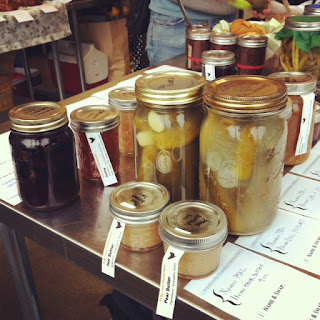The Super Hubs and I spent a few hours yesterday afternoon extending the hen house in our coop, so I thought you might like a tour to see how our little coop lays out.
 |
| Pollo Loco Chook Palace |
We built this coop very quickly in the Spring of 2010 after we decided to move into my childhood home. My parents were buying a new house and we needed to get our chickens moved so we could put our first little house on the market.
We salvaged 2x4's and other wood from family and friends and craigslist. We had to purchase the hardware cloth and the roofing, but the rest of the coop is all salvaged and reclaimed. We sited the coop along the back wall of the garage and in a corner with the property fence....so it is very protected from any Winter winds and shaded from most Summer sun. The large people sized door makes it easy to get in and clean out the coop.
The run is fully enclosed and is about 65 square feet. The wood frame walls sit on CMU blocks we found in the basement to keep them mostly out of the wet ground. The hardware cloth is buried 12 inches into the ground on all sides to prevent digging predators and rodents from getting into the coop.
 |
| Egg Access |
I placed a little garbage can I found at a garage sale next to the hen house doors so that I can scoop out droppings. This eventually gets dumped into our big composter. Below the egg doors is another access door to feed the girls each morning without having to go into the coop. We use old carabiners to latch the doors shut.
 |
| View of food bucket, grit and oyster shell |
I have not been able to bring myself to pay out for expensive chicken feeders, so I have improvised with containers I already had. I just tied the grit and oyster shell containers to the hardware cloth with wire I use for gardening, and that is a utility hook holding the feed bucket.
 |
| Pepper at the waterer and our large composter beyond |
We found an auto waterer, brooder, thermometer set up on craigslist for a steal. The large composter is located just outside the run.
 |
| Close up of the auto-waterer |
This auto-waterer is connected to our rain barrel, so it is very low maintenance. It does not freeze here for very long so I only have to deal with supplemental water for a week or so in the Winter.
 |
| View of entry to the hen house |
Yesterday, we extended the hen house, so now the girls enter from the other end of the run. Last Spring we got some river sand for free that was leftover from a friends yard project. We use this in our run and it has solved our drainage problem...and the chooks like to dig in it.
 |
| New roost bars and step into nest box area |
We enlarged the hen house to accommodate two roost bars...so that we can get five baby chicks this week! When they are all grown, the old girls and the young girls will all share this hen house. For now, we have left the front open so there is plenty of ventilation...I may re-think that further on into Winter. I have seen many coop examples in the Mid-west where one side is left open, even in Winter. Ventilation is much more important for the girls health, they can huddle together on the roost bars to keep warm. Don't worry, I will do many foot checks to be sure they are warm!
 |
| Rooster hook found at a thrift store, painted to match the roofing |































